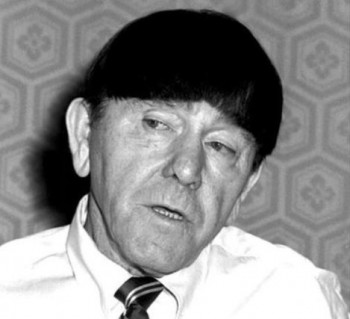Moe Howard (Moses Harry Horwitz)

Moe Howard
From a very early age he was interested in acting, a talent that was helped along by his voracious memory and capacity for memorizing just about anything, including all of the many books he read and all of the plays he saw when he was skipping school. His parents, however, were displeased by his constant truancy and his desire to have a career in show business, so he enrolled at the Baron DeHirsch Trade School in New York, where he took a class in electric shop. However, this only lasted a few months, and he returned to his original desire to be in show business. In 1909 he became an errand boy at the Vitagraph Studios, which were based in Brooklyn. In short time, his hard work and persistence paid off and he was soon acting in films produced by the studio, not running errands for its stars. His family thought he was losing his mind when he began acting like his characters at home, but he reassured them that was not the case by telling them about his new job. Unfortunately, the majority of the films he made for Vitagraph were lost when there was a fire at their film library on July 2, 1910. Over the following decade he continued to perform in various modes of entertainment, such as singing and performing in a showboat troupe. In 1922 he and his older brother Shemp began working vaudeville with his childhood friend Ted Healy, whom they had known since 1909. Three years later, in 1925, Larry Fine joined their act. That same year he married Helen Schonberger (a cousin of Harry Houdini). This marriage was very successful and happy, lasting nearly 50 years, until his death. In 1926, when Helen became pregnant with their daughter Joan, she asked him to leave vaudeville so they could concentrate on their new family. He agreed to this request, unsuccessfully working in real estate for a year, and then, just as unsuccessfully, opening his own retail store. It became clear that he wasn’t cut out for a life outside of show business, and so in 1927 he returned to performing. He worked on and off directing and producing plays at Bensonhurst’s Jewish Community House, and a short time later returned to performing with his old vaudeville gang. They experienced much success together, and the good reviews continued when they ventured into Broadway and later into films, even after Shemp was replaced by their youngest brother Jerome, who was later to be nicknamed Curly. After making quite a number of films with Ted Healy, they parted ways in 1934 and began making short subjects at Columbia as the Three Stooges. Over the next 24 years they starred in 190 two-reelers, occasionally also appearing in features. However, it wasn’t until 1959, after both Shemp and Curly had passed away and the act had finished their quota of two-reelers with Joe Besser, who was replaced by Joe DeRita, that they were actually put in feature-length films of their own, not just as supporting players to a bigger star. They made six features from 1959 to 1963, and throughout the 1960s also constantly made television appearances, starred in commercials, marketed Three Stooges merchandise aimed at children, who at the time were their core audience, and recorded a number of albums. A consummate professional, he was working, appearing on television, and lecturing at college campuses right up till the last days of his life. He lived for his work. Although the Moe Howard fans saw on-screen was very bossy and short-tempered, his real life off-screen persona was the complete opposite. He was the only Stooge who was good at managing money, and died very wealthy as a result. He also always insisted the others turn over part of their salaries to him, so they wouldn’t waste all of their money on luxuries, gambling, and women. He also loved buying gifts for friends and relatives; he rarely showed his emotions, so he felt this was the best way to express his love and fondness for others. Following in the example of his mother, he also worked for a number of charities, such as the Spastic Children’s Guild (of which he was a three-time president). One of his duties for this organization was playing Santa Claus to the sick children. Another example of his charitable generosity was when, without even being asked, he went grocery shopping for Emil Sitka (a frequent character actor he worked with), his wife, and their seven children for Christmas. Sitka arrived home and found his cupboards and the refrigerator incredibly full of food, and wrote a letter which said, “The oil burns for eight days during Hanukkah—but my torch burns in gratitude for you forever.” He also found time to enjoy a number of hobbies, such as ceramics, making hooked rugs, philatelism (stamp collecting), wine-making, numismatism (coin collecting), and midget auto racing. Another big facet of his personality was that of a devoted family man. He and his wife Helen had two children, Joan and Paul, and provided them with a very warm close-knit family. He was very romantic towards his wife, writing her hundreds of love poems when they first married, and on their tenth anniversary calling the house and disguising his voice, asking Helen if she would take Moe Horwitz for her lawful wedded husband. He then performed the entire wedding ceremony over the phone, and at the end of the proceedings sang their wedding song, “Oh Promise Me.” He passed away a month before what would have been their fiftieth wedding anniversary, of lung cancer, at the age of seventy-eight.
Born
- June, 19, 1897
- Bensonhurst, Brooklyn, New York
Died
- May, 04, 1975
- Los Angeles, California
Cause of Death
- lung cancer
Cemetery
- Hillside Memorial Park
- Culver City, California



